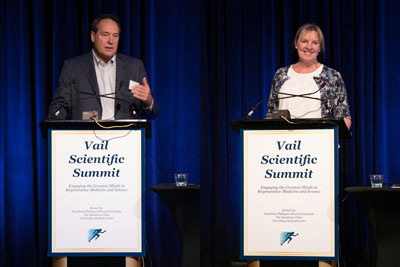Dr. Paul Robbins & Dr. Laura Niedernhofer - "A Perfect Science"

At the Scripps Research Institute in Jupiter, Fla, -- and for a few days at the recent Third Annual Vail Scientific Summit hosted by the Steadman Philippon Research Institute – scientific research has truly become a family affair.
Dr. Paul Robbins and Dr. Laura Niedernhofer both work in the Department of Molecular Medicine at the Florida campus of Scripps in Jupiter, a town near West Palm Beach in South Florida.
Both of them were also featured speakers at the Summit in Vail. Robbins delivered one of the conference’s keynote addresses (“Clinically Relevant Approaches to Extend Health Span”) and was followed onto the podium by Niedernhofer. And the two of them chaired that morning’s group discussion on the topic of aging.
Working together certainly was not new to them as evidenced by their shared time on the faculty at Scripps. But their time together goes well beyond the office, the classroom and conferences at resort hotels with fellow scientists.
Robbins and Niedernhofer are also a couple – as in they share a home, a mortgage and a life together.
For two professors who hold Ph.D’s and have spent much of their adult lives in laboratories, is living together really a “perfect science?”
“It’s been a very complementary relationship for us because we both have our strengths and weaknesses in science, and likewise have our strengths and weaknesses in our private lives,” said Robbins, with a hint of a smile. “It’s actually been wonderful. We spend 24 hours a day together. We’re usually at work seven days a week. And when we’re at home, we talk about our research and the directions we’re going.
“I’m much more of a 30,000-foot-view guy,” admitted Robbins, “and she’s the one that deals with the details, both at work and at home, and that has led to a very successful partnership. All the way around.”
Niedernhofer agreed and added a little more background to Robbins’ assessment.
“What’s really fun too is I think we both entered the aging field at the same time, about 10-12 years ago,” said Niedernhofer. “It certainly wasn’t on anybody’s radar screen at the time so I feel like we got in on the ground floor, and we’re already standing on the shoulders of giants.”
And some of those “giants” were with them at the Summit in Vail.
“One of the focuses of this Summit has been aging,” said Robbins. “(Dr.) Johnny (Huard, Chief Scientific Officer at SPRI and co-chair and founder of the Vail Scientific Summit) as the organizer has realized that aging is a focal point on almost everything he and the others in the field are working on.
“Luckily, I am already collaborating with many of the people at the symposium,” continued Robbins, “and those that are not will probably leave here and find themselves collaborating with many new colleagues.”
“Aging is very complicated and there is no one scientist that can master that big of a problem,” said Niedernhofer. “It’s great to meet face-to-face with people that are dealing with bone, muscle or cartilage, all of which are affected by aging.
“This Summit has been really valuable to me because I have met people and colleagues that are at the top of this game and that will change the way I do research,” added Niedernhofer.”
“The unique aspect of this symposium is to bring top clinicians together with top basic researchers and that usually doesn’t happen,” summed up Robbins. “The value is bringing them together and not only for four days in Vail, but hopefully opening the lines of communication that leads to collaboration down the road.”
That collaboration clearly already exists in Jupiter.
“We came from very different perspectives,” said Niedernhofer. “Paul has a strong background in auto-immune diseases, understanding immunology with an orthopaedic background. I came into this study and research from understanding damage that drives aging and how we can get rid of it. So, it has been extremely complementary – in the lab and of course at home.”
A “perfect science?” Well, the two professors certainly seem to be enjoying their time researching the answer to that question. Perhaps that will be the topic of their presentation at the next Vail Scientific Summit!

